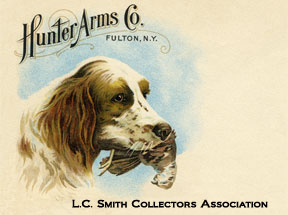|
Answer provided by Tom Archer
I've seen a fair number of Smith guns with barrels added by the factory; all had a serial number stamp identical to the serial number on the frame (except for letter prefix stamps); and the second set (new added barrels) would be stamped with the number “2” usually on the fore iron hanger lug. If the owner also ordered an extra fore end for his new barrels, the fore iron would also be serial numbered to the original serial number stamped on the frame; and likewise carry a separate “2” stamp to designate it as the fore iron specifically fitted to that second set of barrels. This same procedure was observed on those rare Smith guns with three sets of barrels, with the only difference being a “3” stamp in the places noted above.
Barrels added at a later date will typically be engraved in the standard pattern for that particular grade; but, because the additional barrels are seldom engraved by the individual who engraved the gun originally, one will usually see small; but very obvious pattern differences. This same trait is typically seen in later added fore iron engraving; and one will often also be able to see slight differences in checkering styles between artisans of different periods when comparing early and later fore arm checkering.
Then there are the odd factory-fitted second barrel sets where the second set is “out of grade” standards for the gun to which they are fitted. I have observed several mid to high-grade Smith guns with a second set of later added Armor Steel barrels; some had their own fore iron, and others utilized the same fore iron as the original barrel set. These oddities were always the result of customer choice; and that choice the result to same money. Given the fact that Armor Steel barrels enjoyed a great reputation; and that the gun works priced extra barrels at one-half the retail price of each grade, it was a wise choice for the typical shooter. As a for instance, if a customer ordered a $250 grade 5E with Nitro Steel barrels; an additional barrel set would cost an additional $125, and an additional fore iron a few dollars more. A set of Armor Steel barrels, barrels that would perform/pattern equally well as the more expensive Nitro Steel barrels, could be had for about $40; the savings was huge money in this era, and was enough to actually purchase a lower grade Smith ejector gun! When such examples are found, they will sometimes be engraved to match the higher grade original barrels, and sometimes not. Also, in instances where these additional barrels are fitted with their own fore iron, the iron may be engraved and checkered to original grade standards; or in may not, again according to original customer preference.
Finally, later added barrels are sometimes easily spotted due to the features they exhibit. For instance, a Syracuse era gun with an extra set of barrels having the Fulton, NY address, a dogs head Bakelite medallion in the forearm wood, and the Fulton styled ebony tip inlay is a sure indication that particular set of barrels was fitted in Fulton, NY and long after Hunter purchased the gun works and moved them from Syracuse. Also, pre-1913 era Smith guns are occasionally seen with two sets of barrels where one set features a factory fitted ventilated rib barrel and beavertail fore arm. Such a set-up is another obvious indicator that the vent-rib barrel was a later addition, as vent ribs and beavertails were not cataloged until the 1920s.
Hunter Arms did not accept used barrels as "trade-ins" to re-use, or retrofit to another gun (probably for liability reasons, but the gun works was in business to sell new guns and barrels, so I suspect there was a profit motive there also); so it is highly unlikely the gun works would have fitted a used set of barrels with an odd serial number to another Smith gun, although one will see a lot of Smith guns with non-original/odd serial numbered barrels fitted aftermarket by skilled gunsmiths.; and in some instances the serial number stamp may be changed to match the number on the frame. In those cases it is usually easy to identify the number stamps as not original as the new numbers will not be of the same size, style, spacing, or consistency as the originals on the frame. It is also very difficult to weld over old serial numbers and smooth the welded-over surface so that the attempt is indiscernible when removing original numbers.
I've never seen a stamping mistake on a high grade Smith, but it is not uncommon to see over-stamps, out of line stamps, etc. on lower grade Smith guns. It seems to me that it was not the policy of Hunter Arms to weld over; then smooth and re-stamp a serial number mistake, mistakes were simply corrected with an over-stamp. I've seen one C grade Syracuse hammer gun that was factory converted to a No. 2E; the original serial number from the C Grade frame was retained, and the C grade stamp was over-stamped with the new “2E” stamp. In this instance the only part retained from the old Syracuse hammer gun and used in the construction of the new 2E grade gun was the original set of Syracuse barrels. Therefore, based on this discovery, although the gun works would not retrofit used barrels to another’s gun, it was obvious that the gun works, upon customer request, would take a customer’s good set of used barrels and build him a new gun around that key component.
- BACK TO FAQs
COPYRIGHT
L.C. Smith Collectors
Association 2015
Updated 02/17/2015
|

